Prediction of FRCM–Concrete Bond Strength with Machine Learning Approach
Abstract
:1. Introduction
2. FRCM–Concrete Bond Test
2.1. Single-Shear Lap Test
2.2. Double-Shear Lap Test
3. Research Significance
4. Experimental Database Collection
4.1. Database
4.2. Performance Indices
4.3. Pre-Processing of Data
4.4. Machine Learning Methods
4.4.1. Linear Regression
4.4.2. Regression Tree
4.4.3. Support Vector Machine (SVM)
4.4.4. Gaussian Process Regression (GPR)
4.4.5. Ensembles of Trees
4.4.6. Artificial Neural Network
5. Results and Discussion
6. Conclusions
- The GPR and optimized GPR model can accurately predict the bond strength with R-value 0.9435 and 0.9310 (for training) and 0.9432 and 0.9137 (for testing), respectively.
- ANN model founds third best fitted model to predict the bond strength with R-value 0.8871 for training and 0.9538 for testing.
- According to the R, RMSE, MAE and MAPE assessment standards, the precision of the analytical approximations of the optimized GPR, GPR, ANN, optimized ensemble, linear regression, optimized SVM, SVM, ensemble, optimal regression tree and regression tree decreases subsequently.
- The error value distribution was used to assess the optimized GPR, GPR and ANN models’ resilience and accuracy. The suggested model surpasses other ML models by having the lowest absolute error values, which are confined to less than 7 to 8 kN of the P range.
Author Contributions
Funding
Institutional Review Board Statement
Informed Consent Statement
Data Availability Statement
Acknowledgments
Conflicts of Interest
References
- Sidiropoulos, S.; Han, K.; Majumdar, A.; Washington, Y.O. Robust identification of air traffic flow patterns in Metroplex terminal areas under demand uncertainty. Transp. Res. Part Emerg. Technol. 2017, 75, 212–227. [Google Scholar] [CrossRef]
- Mullard, J.A.; Stewart, M.G. Life-Cycle Cost Assessment of Maintenance Strategies for RC Structures in Chloride Environments. J. Bridge Eng. 2012, 17, 353–362. [Google Scholar] [CrossRef]
- Navarro, I.J.; Yepes, V.; Martí, J.V. Life Cycle Cost Assessment of Preventive Strategies Applied to Prestressed Concrete Bridges Exposed to Chlorides. Sustainability 2018, 10, 845. [Google Scholar] [CrossRef] [Green Version]
- Ali, B.S.; Ochieng, W.; Majumdar, A.; Schuster, W.; Chiew, T.K. ADS-B System Failure Modes and Models. J. Navig. 2014, 67, 995–1017. [Google Scholar]
- Firmo, J.P.; Correia, J.R.; Bisby, L.A. Bisby. Fire Behaviour of FRP-Strengthened Reinforced Concrete Structural Elements: A State-of-the-Art Review. Compos. Part B Eng. 2015, 80, 198–216. [Google Scholar] [CrossRef]
- Spadea, G.; Bencardino, F.; Sorrenti, F.; Swamy, R.N. Structural Effectiveness of FRP Materials in Strengthening RC Beams. Eng. Struct. 2015, 99, 631–641. [Google Scholar] [CrossRef]
- Tang, Y.; Yao, Y.; Cang, J. Structural and Sensing Performance of Rc Beams Strengthened with Prestressed near-Surface Mounted Self-Sensing Basalt FRP Bar. Compos. Struct. 2021, 259, 113474. [Google Scholar] [CrossRef]
- Saini, A.; Prakash, S.S. Analytical Study on the Effectiveness of Hybrid FRP Strengthening on Behaviour of Slender Reinforced Concrete Square Columns. Structures 2021, 33, 4218–4242. [Google Scholar] [CrossRef]
- Jincheng, Y.; Haghani, R.; Blanksvärd, T.; Lundgren, K. Experimental Study of Frp-Strengthened Concrete Beams with Corroded Reinforcement. Constr. Build. Mater. 2021, 301, 124076. [Google Scholar]
- Feng, Z.; Gao, L.; Wu, Y.-F.; Liu, J. Flexural Design of Reinforced Concrete Structures Strengthened with Hybrid Bonded FRP. Compos. Struct. 2021, 269, 113996. [Google Scholar]
- Ababneh, A.N.; Al-Rousan, R.Z.; Ghaith, I.M. Experimental Study on Anchoring of Frp-Strengthened Concrete Beams. Structures 2020, 23, 26–33. [Google Scholar] [CrossRef]
- Justas, S.; Valivonis, J. Concrete Cracking and Deflection Analysis of RC Beams Strengthened with Prestressed FRP Reinforcements under External Load Action. Compos. Struct. 2021, 225, 113036. [Google Scholar]
- Liangliang, W.; Ueda, T.; Matsumoto, K.; Zhu, J.-H. Experimental and Analytical Study on the Behavior of RC Beams with Externally Bonded Carbon-FRCM Composites. Compos. Struct. 2021, 273, 114291. [Google Scholar]
- Ahmed, M.; Refai, A.E. Assessment and Modeling of the Debonding Failure of Fabric-Reinforced Cementitious Matrix (FRCM) Systems. Compos. Struct. 2021, 275, 114394. [Google Scholar]
- Muhammad, K.; Abed, F. Finite Element Parametric Analysis of RC Columns Strengthened with FRCM. Compos. Struct. 2021, 275, 114498. [Google Scholar]
- Alemdar, B.; Hökelekli, E. A Cost-Effective FRCM Technique for Seismic Strengthening of Minarets. Eng. Struct. 2021, 229, 111672. [Google Scholar]
- Gaochuang, C.; Tsavdaridis, K.D.; Larbi, A.S.; Purnell, P. A Simplified Design Approach for Predicting the Flexural Behavior of TRM-Strengthened RC Beams under Cyclic Loads. Constr. Build. Mater. 2021, 285, 122799. [Google Scholar]
- Zhifang, D.; Deng, M.; Zhang, C.; Zhang, Y.; Sun, H. Tensile Behavior of Glass Textile Reinforced Mortar (TRM) Added with Short PVA Fibers. Constr. Build. Mater. 2021, 260, 119897. [Google Scholar]
- Xuan, W.; Lam, C.C.; Iu, V.P. Comparison of Different Types of TRM Composites for Strengthening Masonry Panels. Constr. Build. Mater. 2019, 219, 184–194. [Google Scholar]
- Shichang, L.; Yin, S. Research on the Mechanical Properties of Assembled TRC Permanent Formwork Composite Columns. Eng. Struct. 2021, 247, 113105. [Google Scholar]
- Ngoc, T.C.T.; Nguyen, X.H.; Nguyen, H.C.; Le, D.D. Shear Performance of Short-Span FRP-Reinforced Concrete Beams Strengthened with CFRP and TRC. Eng. Struct. 2021, 242, 112548. [Google Scholar]
- Tala, T.; Vu, X.H.; Michel, M.; Ferrier, E.; Larbi, A.S. Physical, Chemical and Thermomechanical Characterisation of Glass Textile-Reinforced Concretes (TRCC): Effect of Elevated Temperature and of Cementitious Matrix Nature on Properties of TRC. Mater. Today Commun. 2020, 25, 101580. [Google Scholar]
- Shen, L.H.; Wang, J.Y.; Xu, S.L.; Zhao, X.; Peng, Y. Physical, Flexural Behavior of Trc Contained Chopped Fibers Subjected to High Temperature. Constr. Build. Mater. 2020, 262, 120562. [Google Scholar] [CrossRef]
- Naser, M.Z.; Hawileh, R.A.; Abdalla, J.A. Fiber-Reinforced Polymer Composites in Strengthening Reinforced Concrete Structures: A Critical Review. Eng. Struct. 2020, 198, 109542. [Google Scholar] [CrossRef]
- Milani, E.G.; Ghiassi, B. Chapter 20—Advanced Finite Element Modeling of Textile-Reinforced Mortar Strengthened Masonry. In Numerical Modeling of Masonry and Historical Structures; Ghiassi, B., Milani, G., Eds.; Woodhead Publishing: Amsterdam, The Netherlands, 2019; pp. 713–743. [Google Scholar]
- Koutas, L.N.; Tetta, Z.; Bournas, D.A.; Triantafillou, T.C. Strengthening of Concrete Structures with Textile Reinforced Mortars: State-of-the-Art Review. J. Compos. Constr. 2019, 23, 03118001. [Google Scholar] [CrossRef]
- Xuan, W.; Lam, C.C.; Iu, V.P. Bond Behaviour of Steel-TRM Composites for Strengthening Masonry Elements: Experimental Testing and Numerical Modelling. Constr. Build. Mater. 2019, 253, 119157. [Google Scholar]
- Alexandru, C.; Kumar, A.; Vlach, T.; Laiblová, L.; Škapin, A.S.; Hájek, P. Property Improvements of Alkali Resistant Glass Fibres/Epoxy Composite with Nanosilica for Textile Reinforced Concrete Applications. Mater. Des. 2016, 89, 146–155. [Google Scholar]
- Scheffler, C.; Gao, S.L.; Plonka, R.; Mäder, E.; Hempel, S.; Butler, M.; Mechtcherine, V. Interphase Modification of Alkali-Resistant Glass Fibres and Carbon Fibres for Textile Reinforced Concrete I: Fibre Properties and Durability. Compos. Sci. Technol. 2009, 69, 531–538. [Google Scholar] [CrossRef]
- Massimo, M.; Nobili, A.; Signorini, C.; Sola, A. Effect of High Temperature Exposure on Epoxy-Coated Glass Textile Reinforced Mortar (GTRM) Composites. Constr. Build. Mater. 2019, 212, 765–774. [Google Scholar]
- Ayman, S.; Elgabbas, F.; Elshafie, H. Tensile Behavior of Basalt Textile-Reinforced Mortar (BTRM). Ain Shams Eng. J. 2021, 13, 101488. [Google Scholar]
- Xuan, C.; Zhuge, Y.; Al-Gemeel, A.N.; Xiong, Z. Compressive Behaviour of Concrete Column Confined with Basalt Textile Reinforced ECC. Eng. Struct. 2021, 243, 112651. [Google Scholar]
- Sai, L.; Wang, X.; Rawat, P.; Chen, Z.; Shi, C.; Zhu, D. Experimental Study and Analytical Modeling on Tensile Performance of Basalt Textile Reinforced Concrete. Constr. Build. Mater. 2021, 267, 120972. [Google Scholar]
- Qingxuan, W.; Ding, Y.; Randl, N. Investigation on the Alkali Resistance of Basalt Fiber and Its Textile in Different Alkaline Environments. Constr. Build. Mater. 2021, 272, 121670. [Google Scholar]
- Halvaei, M.; Jamshidi, M.; Latifi, M.; Ejtemaei, M. Experimental Investigation and Modelling of Flexural Properties of Carbon Textile Reinforced Concrete. Constr. Build. Mater. 2020, 262, 120877. [Google Scholar] [CrossRef]
- Tien, T.M.; Vu, X.H.; Ferrier, E. Experimental and Numerical Investigation of Carbon Textile/Cementitious Matrix Interfacebehaviourfrom Pull-out Tests. Constr. Build. Mater. 2021, 282, 122634. [Google Scholar]
- Ting, G.; Ahmed, A.H.; Curosu, I.; Mechtcherine, V. Tensile Behavior of Hybrid Fiber Reinforced Composites Made of Strain-Hardening Cement-Based Composites (SHCC) and Carbon Textile. Constr. Build. Mater. 2020, 262, 120913. [Google Scholar]
- Du, Y.X.; Shao, X.; Chu, S.H.; Zhou, F.; Su, R.K.L. Strengthening of Preloaded RC Beams Using Prestressed Carbon Textile Reinforced Mortar Plates. Structures 2021, 30, 735–744. [Google Scholar] [CrossRef]
- Goliath, K.B.; Cardoso, D.C.; Silva, F.D. Flexural Behavior of Carbon-Textile-Reinforced Concrete I-Section Beams. Compos. Struct. 2021, 260, 113540. [Google Scholar] [CrossRef]
- Aljazaeri Zena, R.; John, J.M. Fatigue and Flexural Behavior of Reinforced-Concrete Beams Strengthened with Fiber-Reinforced Cementitious Matrix. J. Compos. Constr. 2017, 21, 04016075. [Google Scholar] [CrossRef]
- Pino, V.; Akbari Hadad, H.; De Caso y Basalo, F.; Nanni, A. Performance of Frcm-Strengthened Rc Beams Subject to Fatigue. J. Bridge Eng. 2017, 22, 04017079. [Google Scholar] [CrossRef]
- Emre, A.; Rashidi, M. Axial Behavior of Concrete Confined with Flax Fiber-Reinforced Polymers. Mater. Today Commun. 2021, 28, 102646. [Google Scholar]
- Giuseppe, F.; Pepe, M.; Martinelli, E.; Filho, R.D.T. Tensile Behavior of Flax Textile Reinforced Lime-Mortar: Influence of Reinforcement Amount and Textile Impregnation. Cem. Concr. Compos. 2021, 119, 103984. [Google Scholar]
- Farinha, C.B.; de Brito, J.; Veiga, R. Incorporation of High Contents of Textile, Acrylic and Glass Waste Fibres in Cement-Based Mortars. Influence on Mortars’ Fresh, Mechanical and Deformability Behaviour. Constr. Build. Mater. 2021, 303, 124424. [Google Scholar] [CrossRef]
- Bello, D.C.; Brito, C.; Boem, I.; Cecchi, A.; Gattesco, N.; Oliveira, D.V. Experimental Tests for the Characterization of Sisal Fiber Reinforced Cementitious Matrix for Strengthening Masonry Structures. Constr. Build. Mater. 2019, 219, 44–55. [Google Scholar] [CrossRef] [Green Version]
- Rambo, D.A.S.; de Oliveira, C.U.; Salvador, R.P.; Toledo Filho, R.D.; Gomes, O.D.F.M.; de Andrade Silva, F.; de Melo Vieira, M. Sisal Textile Reinforced Concrete: Improving Tensile Strength and Bonding through Peeling and Nano-Silica Treatment. Constr. Build. Mater. 2021, 301, 124300. [Google Scholar] [CrossRef]
- De Souza Castoldi, R.; de Souza, L.M.S.; de Andrade Silva, F. Comparative Study on the Mechanical Behavior and Durability of Polypropylene and Sisal Fiber Reinforced Concretes. Constr. Build. Mater. 2019, 211, 617–628. [Google Scholar] [CrossRef]
- Jung, K.; Hong, K.; Han, S.; Park, J.; Kim, J. Prediction of Flexural Capacity of RC Beams Strengthened in Flexure with FRP Fabric and Cementitious Matrix. Int. J. Polym. Sci. 2015, 2015, 868541. [Google Scholar] [CrossRef] [Green Version]
- Chen, S.-Z.; Zhang, S.-Y.; Han, W.-S.; Wu, G. Ensemble learning based approach for FRP-concrete bond strength prediction. Constr. Build. Mater. 2021, 302, 124230. [Google Scholar] [CrossRef]
- Basran, B.; Kalkan, I.; Bergil, E.; Erdal, E. Estimation of the FRP-concrete bond strength with code formulations and machine learning algorithms. Compos. Struct. 2021, 268, 113972. [Google Scholar] [CrossRef]
- Aghabalaei Baghaei, K.; Hadigheh, S.A. Durability assessment of FRP-to-concrete bonded connections under moisture condition using data-driven machine learning-based approaches. Compos. Struct. 2021, 114576. [Google Scholar] [CrossRef]
- Su, M.; Zhong, Q.; Peng, H.; Li, S. Selected machine learning approaches for predicting the interfacial bond strength between FRPs and concrete. Constr. Build. Mater. 2021, 270, 121456. [Google Scholar] [CrossRef]
- Wang, X.; Liu, Y.; Xin, H. Bond strength prediction of concrete-encased steel structures using hybrid machine learning method. Structures 2021, 32, 2279–2292. [Google Scholar] [CrossRef]
- Sun, J.; Wang, X.; Zhang, J.; Xiao, F.; Sun, Y.; Ren, Z.; Zhang, G.; Liu, S.; Wang, Y. Multi-objective optimisation of a graphite-slag conductive composite applying a BAS-SVR based model. J. Build. Eng. 2021, 44, 103223. [Google Scholar] [CrossRef]
- Abuodeh, O.R.; Abdalla, J.A.; Hawileh, R.A. Prediction of shear strength and behavior of RC beams strengthened with externally bonded FRP sheets using machine learning techniques. Compos. Struct. 2020, 234, 111698. [Google Scholar] [CrossRef]
- Nikoo, M.; Aminnejad, B.; Lork, A. Predicting Shear Strength in FRP-Reinforced Concrete Beams Using Bat Algorithm-Based Artificial Neural Network. Adv. Mater. Sci. Eng. 2021, 2021, 5899356. [Google Scholar] [CrossRef]
- Alam, M.S.; Sultana, N.; Hossain, S.M.Z. Bayesian optimization algorithm based support vector regression analysis for estimation of shear capacity of FRP reinforced concrete members. Appl. Soft Comput. 2021, 105, 107281. [Google Scholar] [CrossRef]
- Chou, J.-S.; Pham, T.-P.-T.; Nguyen, T.-K.; Pham, A.-D.; Ngo, N.-T. Shear strength prediction of reinforced concrete beams by baseline, ensemble, and hybrid machine learning models. Soft Comput. 2020, 24, 3393–3411. [Google Scholar] [CrossRef]
- Fu, B.; Feng, D.-C. A machine learning-based time-dependent shear strength model for corroded reinforced concrete beams. J. Build. Eng. 2021, 36, 102118. [Google Scholar] [CrossRef]
- Gao, J.; Koopialipoor, M.; Armaghani, D.J.; Ghabussi, A.; Baharom, S.; Morasaei, A.; Shariati, A.; Khorami, M.; Zhou, J. Evaluating the bond strength of FRP in concrete samples using machine learning methods. Smart Struct. Syst. 2020, 26, 403–418. [Google Scholar]
- Su, M.; Peng, H.; Yuan, M.; Li, S. Identification of the interfacial cohesive law parameters of FRP strips externally bonded to concrete using machine learning techniques. Eng. Fract. Mech. 2021, 247, 107643. [Google Scholar] [CrossRef]
- Naser, M.Z. Machine Learning Assessment of Fiber-Reinforced Polymer-Strengthened and Reinforced Concrete Members. ACI Struct. J. 2021, 117, 237–251. [Google Scholar]
- He, M.; Wang, Y.; Ramakrishnan, K.R.; Zhang, Z. A comparison of machine learning algorithms for assessment of delamination in fiber-reinforced polymer composite beams. Struct. Health Monit. 2020, 20, 1997–2012. [Google Scholar] [CrossRef]
- Almustafa, M.K.; Nehdi, M.L. Machine learning prediction of structural response for FRP retrofitted RC slabs subjected to blast loading. Eng. Struct. 2021, 244, 112752. [Google Scholar] [CrossRef]
- Alwanas, A.A.H.; Al-Musawi, A.A.; Salih, S.Q.; Tao, H.; Ali, M.; Yaseen, Z.M. Load-carrying capacity and mode failure simulation of beam-column joint connection: Application of self-tuning machine learning model. Eng. Struct. 2019, 194, 220–229. [Google Scholar] [CrossRef]
- Rezaiee-Pajand, M.; Karimipour, A.; Abad, J.M.N. Crack Spacing Prediction of Fibre-Reinforced Concrete Beams with Lap-Spliced Bars by Machine Learning Models. Iran. J. Sci. Technol. Trans. Civ. Eng. 2021, 45, 833–850. [Google Scholar] [CrossRef]
- Nguyen, H.D.; Zhang, Q.; Choi, E.; Duan, W. An improved deflection model for FRP RC beams using an artificial intelligence-based approach. Eng. Struct. 2020, 219, 110793. [Google Scholar] [CrossRef]
- Bencardino, F.; Condello, A.; Ashour, A.F. Single-lap shear bond tests on Steel Reinforced Geopolymeric Matrix-concrete joints. Compos. Part B Eng. 2017, 110, 62–71. [Google Scholar] [CrossRef] [Green Version]
- Caggegi, C.; Sciuto, D.; Cuomo, M. Experimental study on effective bond length of basalt textile reinforced mortar strengthening system: Contributions of digital image correlation. Measurement 2018, 129, 119–127. [Google Scholar] [CrossRef]
- Sneed, L.H.; D’Antino, T.; Carloni, C.; Pellegrino, C. A comparison of the bond behavior of PBO-FRCM composites determined by double-lap and single-lap shear tests. Cem. Concr. Compos. 2015, 64, 37–48. [Google Scholar] [CrossRef]
- De Felice, G.; Aiello, M.A.; Caggegi, C.; Ceroni, F.; De Santis, S.; Garbin, E.; Viskovic, A. Recommendation of RILEM Technical Committee 250-CSM: Test method for Textile Reinforced Mortar to substrate bond characterization. Mater. Struct. 2018, 51, 1–9. [Google Scholar] [CrossRef]
- Raoof, S.M.; Bournas, D.A. Bond between TRM versus FRP composites and concrete at high temperatures. Compos. Part B Eng. 2017, 127, 150–165. [Google Scholar] [CrossRef]
- Carloni, C.; D’Antino, T.; Sneed, L.H.; Pellegrino, C. Role of the Matrix Layers in the Stress-Transfer Mechanism of FRCM Composites Bonded to a Concrete Substrate. J. Eng. Mech. 2015, 141, 04014165. [Google Scholar] [CrossRef]
- Friedman, J.; Hastie, J.; Tibshirani, R. The Elements of Statistical Learning; Springer: New York, NY, USA, 2009. [Google Scholar]
- D’Ambrisi, A.; Feo, L.; Focacci, F. Experimental analysis on bond between PBO-FRCM strengthening materials and concrete. Compos. Part Eng. 2013, 44, 524–532. [Google Scholar] [CrossRef]
- Awani, O.; Refai, A.E.; El-Maaddawy, T. Bond characteristics of carbon fabric-reinforced cementitious matrix in double shear tests. Constr. Build. Mater. 2015, 101, 39–49. [Google Scholar] [CrossRef]
- Raoof, S.M.; Koutas, L.N.; Bournas, D.A. Bond between textile-reinforced mortar (TRM) and concrete substrates: Experimental investigation. Compos. Part B Eng. 2016, 98, 350–361. [Google Scholar] [CrossRef]
- Younis, A.; Ebead, U. Bond characteristics of different FRCM systems. Constr. Build. Mater. 2018, 175, 610–620. [Google Scholar] [CrossRef]
- Li, S.; Yin, S.; Gao, Y. Analysis of Interface Properties Between TRC and Concrete Under Chloride Attack Based on Fracture Energy. Int. J. Concr. Struct. Mater. 2020, 14, 28. [Google Scholar] [CrossRef]
- Tran, C.T.M.; Stitmannaithum, B.; Ueda, T. Investigation of The Bond Behaviour Between PBO-FRCM Strengthening Material and Concrete. J. Adv. Concr. Technol. 2014, 12, 545–557. [Google Scholar] [CrossRef] [Green Version]
- Sneed, L.H.; D’Antino, T.; Carloni, C. Investigation of Bond Behavior of PBO Fiber-Reinforced Cementitious Matrix Composite-Concrete Interface. Mater. J. 2014, 111, 569–580. [Google Scholar]
- Ceroni, F.; Bonati, A.; Galimberti, V.; Occhiuzzi, A. Effects of Environmental Conditioning on the Bond Behavior of FRP and FRCM Systems Applied to Concrete Elements. J. Eng. Mech. 2018, 144, 04017144. [Google Scholar] [CrossRef]
- D’Antino, T.; Sneed, L.H.; Carloni, C.; Pellegrino, C. Influence of the substrate characteristics on the bond behavior of PBO FRCM-concrete joints. Constr. Build. Mater. 2015, 101, 838–850. [Google Scholar] [CrossRef]
- Chaabene, W.B.; Flah, M.; Nehdi, M.L. Machine learning prediction of mechanical properties of concrete: Critical review. Constr. Build. Mater. 2020, 260, 119889. [Google Scholar] [CrossRef]
- Tripepi, G.; Jager, K.J.; Dekker, F.W.; Zoccali, C. Linear and logistic regression analysis. Kidney Int. 2008, 73, 806–810. [Google Scholar] [CrossRef] [PubMed] [Green Version]
- Montgomery Douglas, C.; Peck, E.A.; Vining, G.G. Linear and logistic regression analysis. In Introduction to Linear Regression Analysis; John Wiley and Sons: Hoboken, NJ, USA, 2021. [Google Scholar]
- Loh, W.Y. Classification and regression trees. Wiley Interdiscip. Rev. Data Min. Knowl. Discov. 2011, 1, 14–23. [Google Scholar] [CrossRef]
- Mur, R.; Díaz, I.; Rodríguez, M. Comparative Study of Surrogate Modelling Techniques Applied to Three Different Chemical Processes. Comput. Aided Chem. Eng. 2020, 48, 145–150. [Google Scholar]
- Richardson, R.R.; Osborne, M.A.; Howey, D.A. Gaussian process regression for forecasting battery state of health. J. Power Sources 2017, 357, 209–219. [Google Scholar] [CrossRef]
- Cheng, L.; Ramchandran, S.; Vatanen, T.; Lietzén, N.; Lahesmaa, R.; Vehtari, A.; Lähdesmäki, H. An additive Gaussian process regression model for interpretable non-parametric analysis of longitudinal data. Nat. Commun. 2019, 10, 1798. [Google Scholar] [CrossRef] [PubMed]
- Lubbe, F.; Maritz, J.; Harms, T. Evaluating the Potential of Gaussian Process Regression for Solar Radiation Forecasting: A Case Study. Energies 2020, 13, 5509. [Google Scholar] [CrossRef]
- Asante-Okyere, S.; Shen, C.; Yevenyo Ziggah, Y.; Moses Rulegeya, M.; Zhu, X. Investigating the Predictive Performance of Gaussian Process Regression in Evaluating Reservoir Porosity and Permeability. Energies 2018, 11, 3261. [Google Scholar] [CrossRef] [Green Version]
- Zimmermann, A. TEnsemble-Trees: Leveraging Ensemble Power Inside Decision Trees. In Proceedings of the International Conference on Discovery Science, Budapest, Hungary, 13–16 October 2008; Springer: Heidelberg, Germany, 2008. [Google Scholar]
- Jerome, H.F. Greedy function approximation: A gradient boosting machine. Ann. Stat. 2001, 29, 1189–1232. [Google Scholar]
- Peterson, K.D. Resting heart rate variability can predict track and field sprint performance. OA J. Sports 2018, 1, 1–9. [Google Scholar]
- McCulloch, W.S.; Pitts, W. A logical calculus of the ideas immanent in nervous activity. Bull. Math. Biophys. 1943, 5, 115–133. [Google Scholar] [CrossRef]
- Firat, M.; Turan, M.E.; Yurdusev, M.A. Comparative analysis of neural network techniques for predicting water consumption time series. J. Hydrol. 2010, 384, 46–51. [Google Scholar] [CrossRef]
- Abbasi, M.; El Hanandeh, A. Forecasting municipal solid waste generation using artificial intelligence modelling approaches. Waste Manag. 2016, 56, 13–22. [Google Scholar] [CrossRef] [PubMed]
- Mashrei, M.A.; Seracino, R.; Rahman, M.S. Application of artificial neural networks to predict the bond strength of FRP-to-concrete joints. Constr. Build. Mater. 2013, 40, 812–821. [Google Scholar] [CrossRef]
- Jahangir, H.; Rezazadeh Eidgahee, D. A new and robust hybrid artificial bee colony algorithm—ANN model for FRP-concrete bond strength evaluation. Compos. Struct. 2021, 257, 113160. [Google Scholar] [CrossRef]
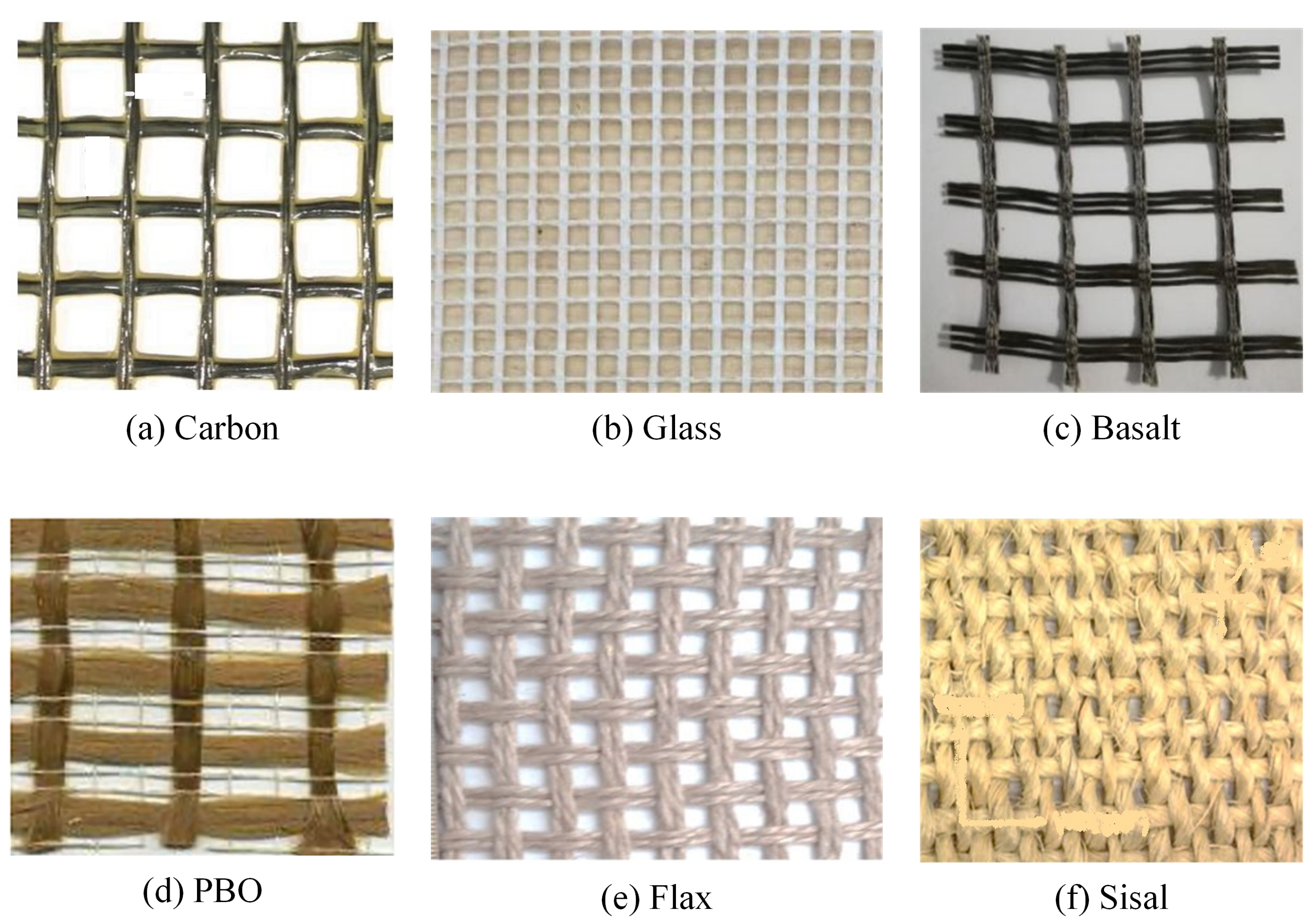
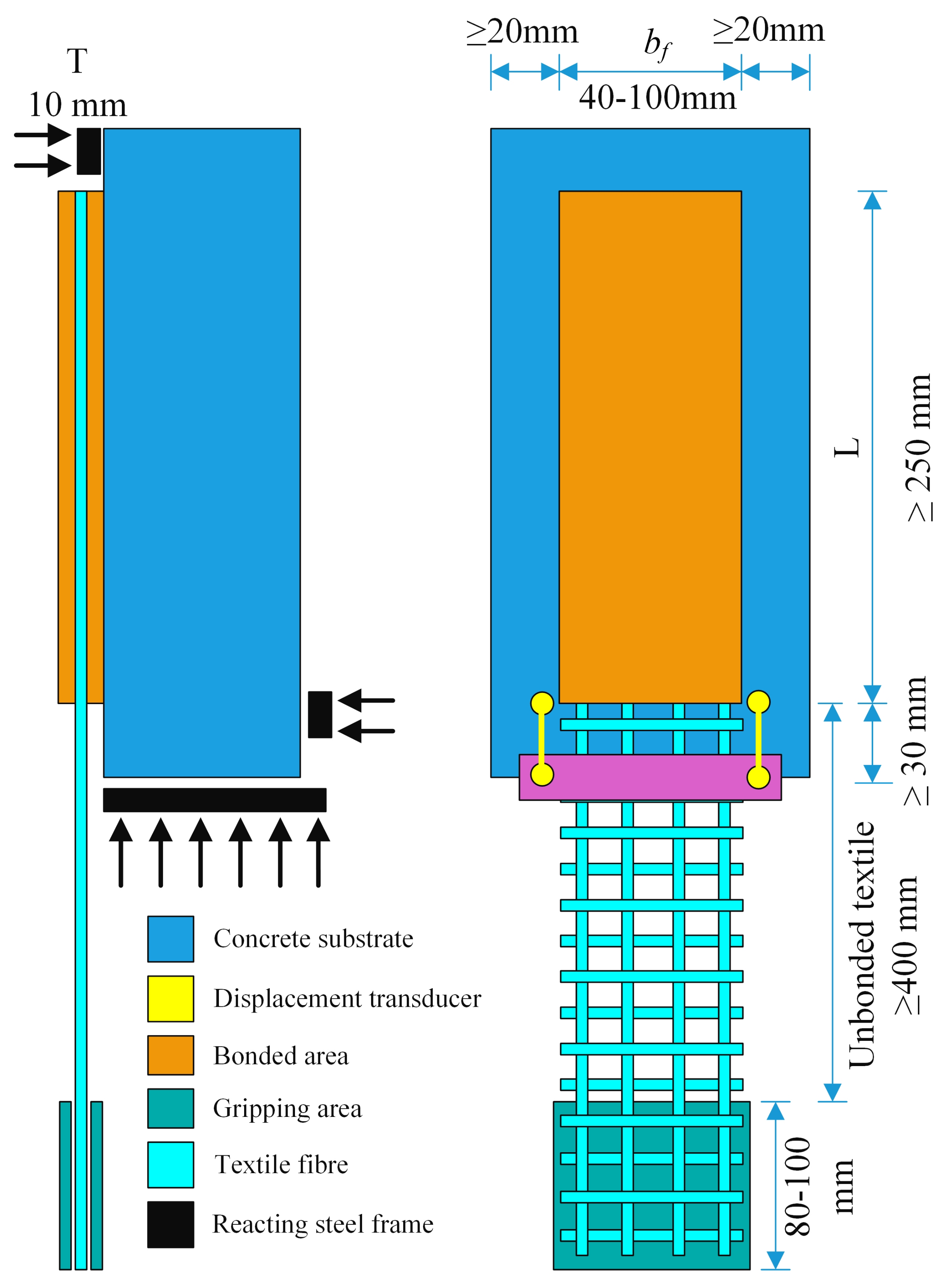
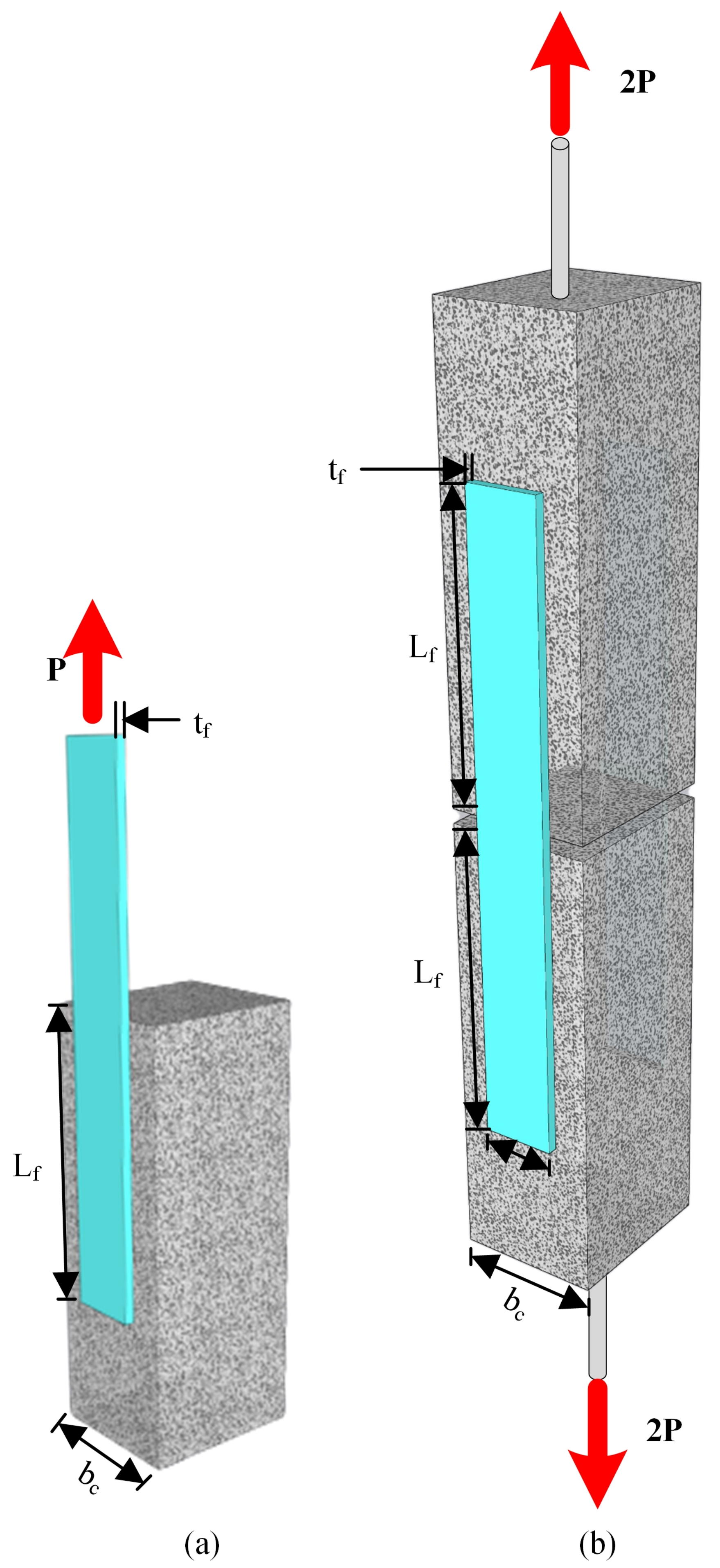

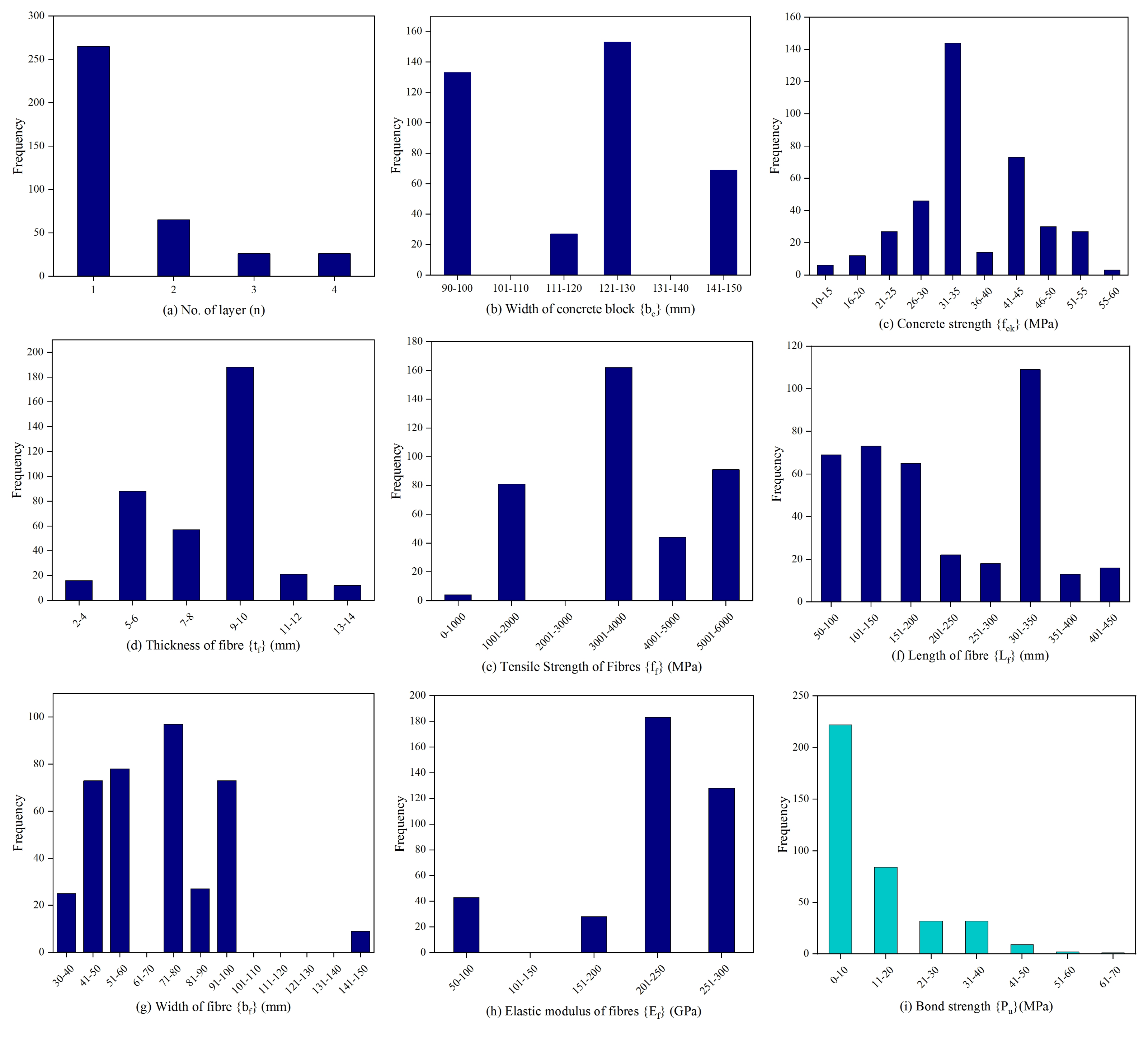
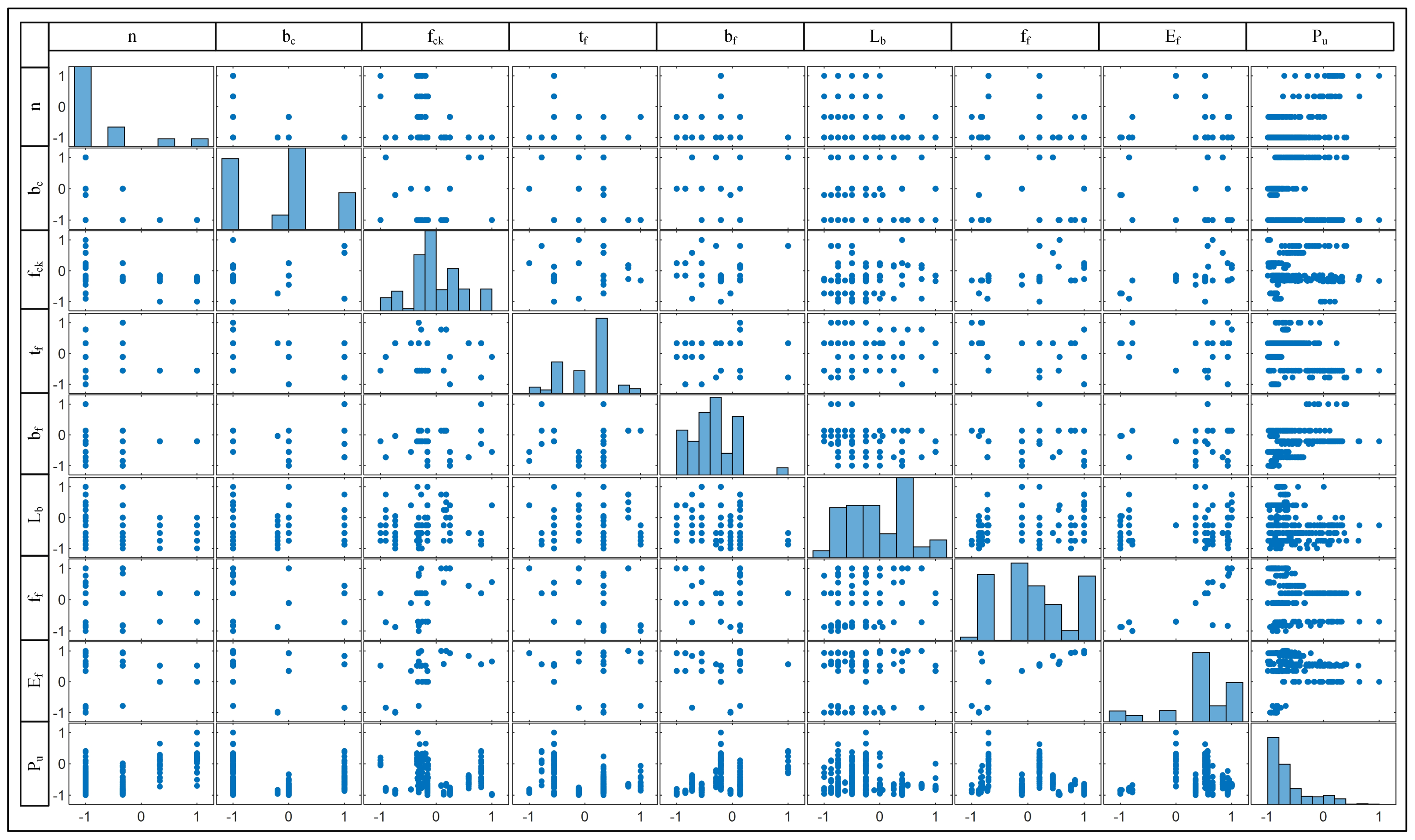
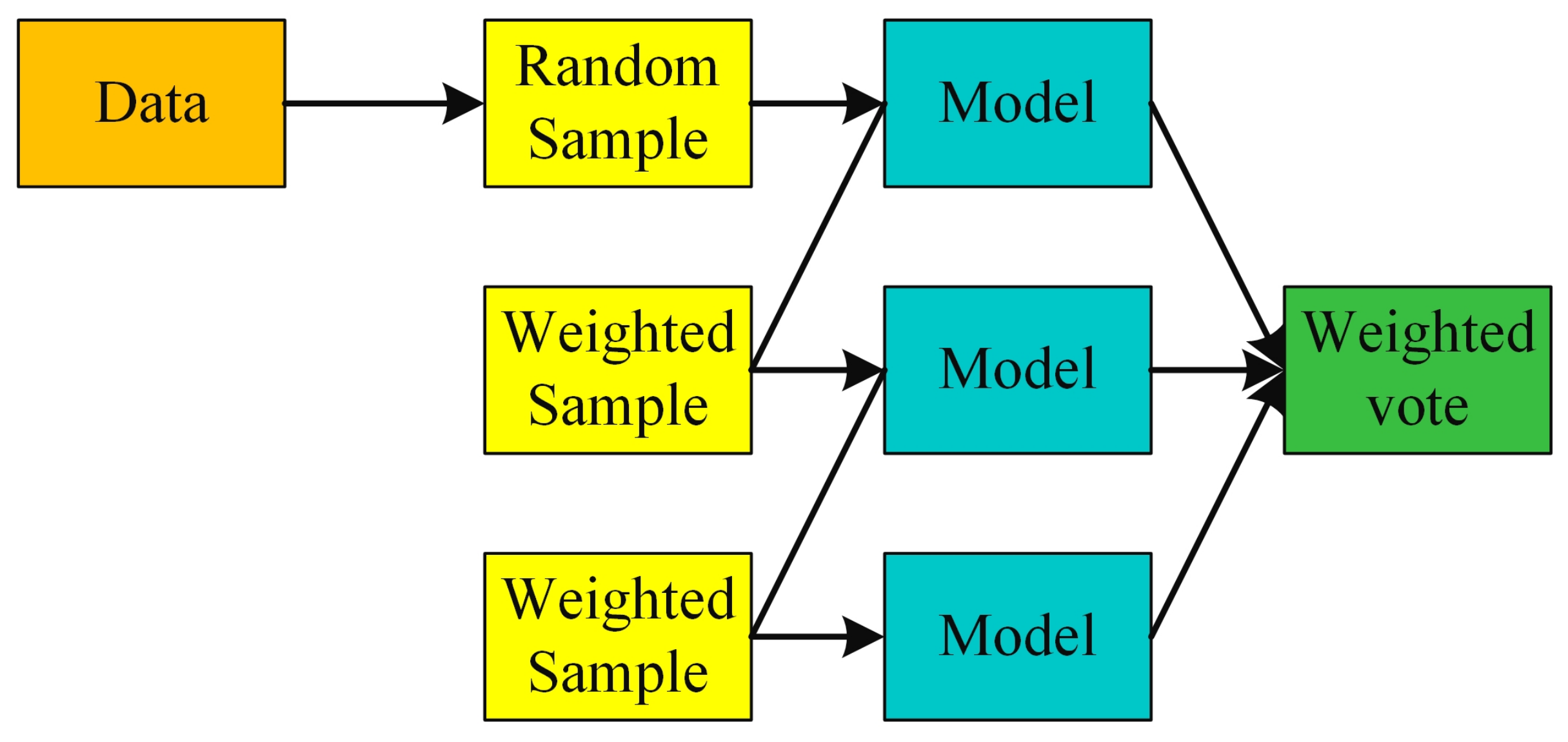
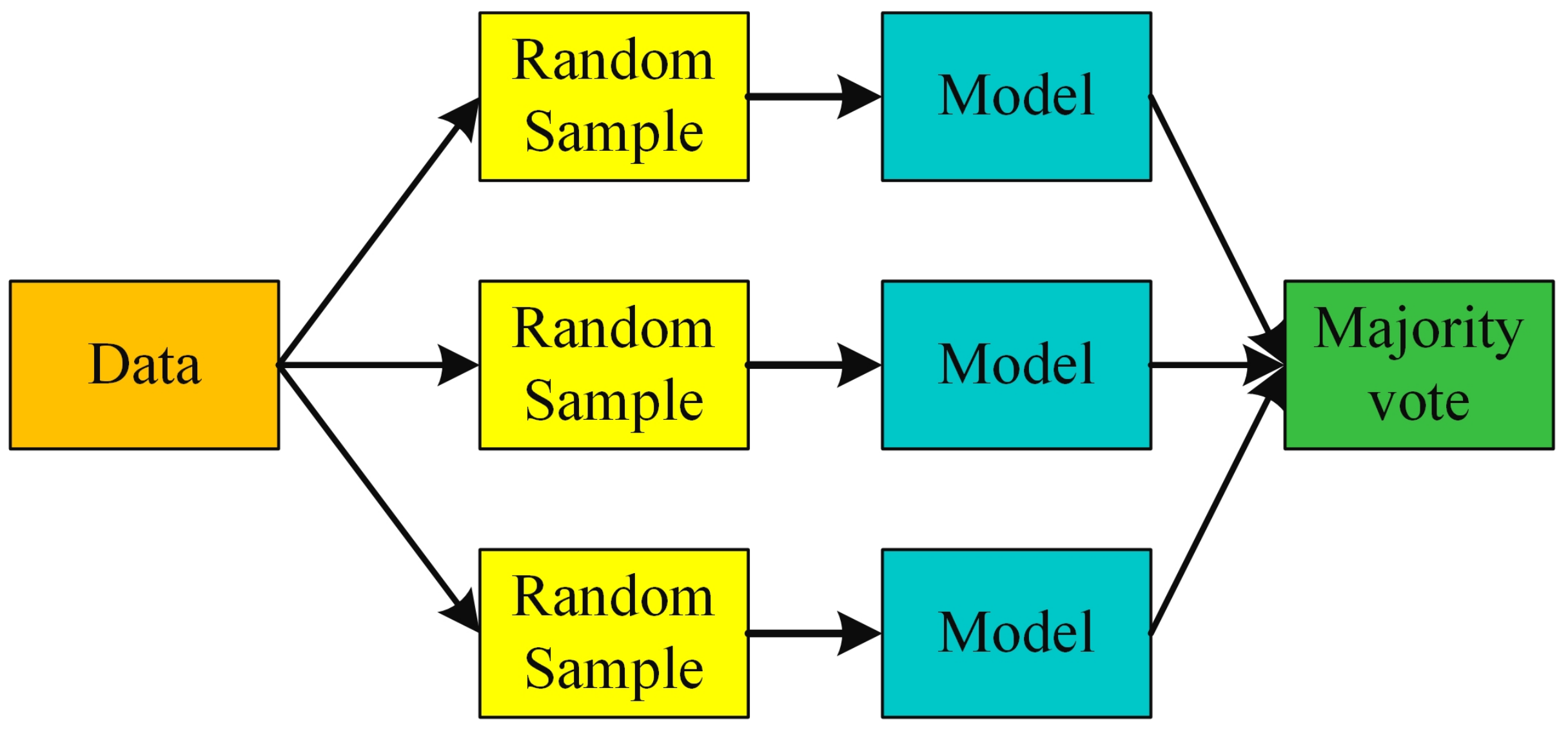
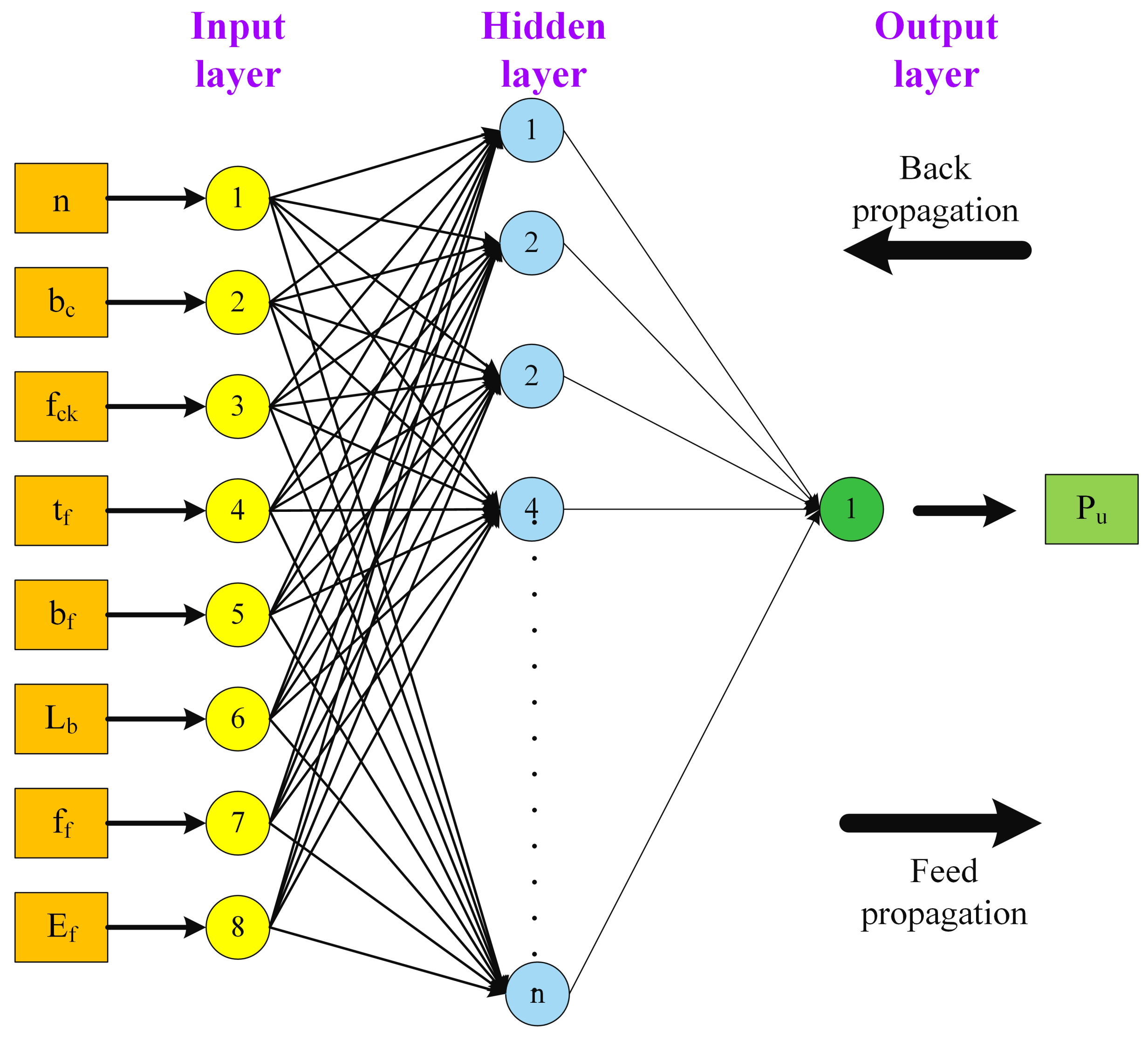
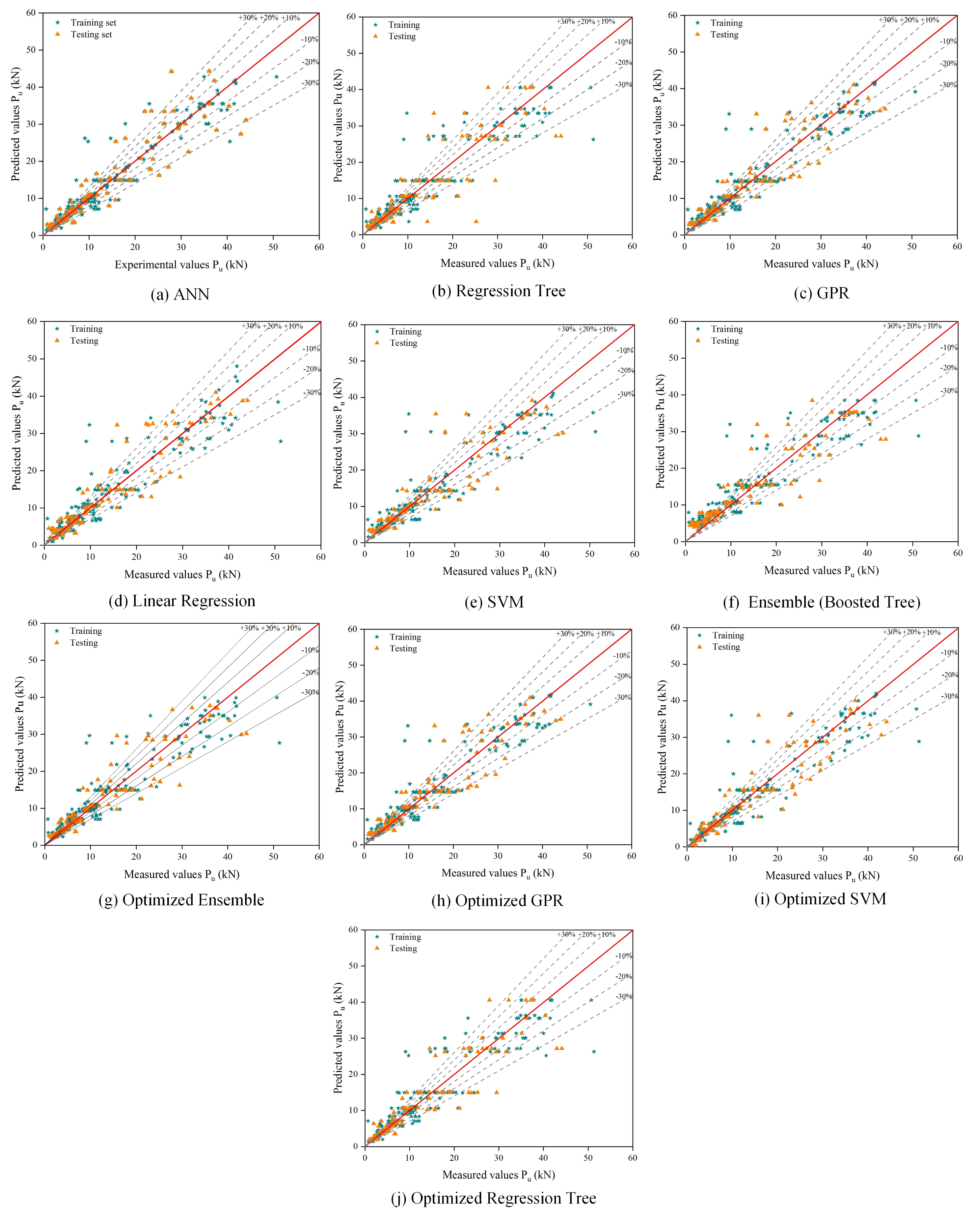
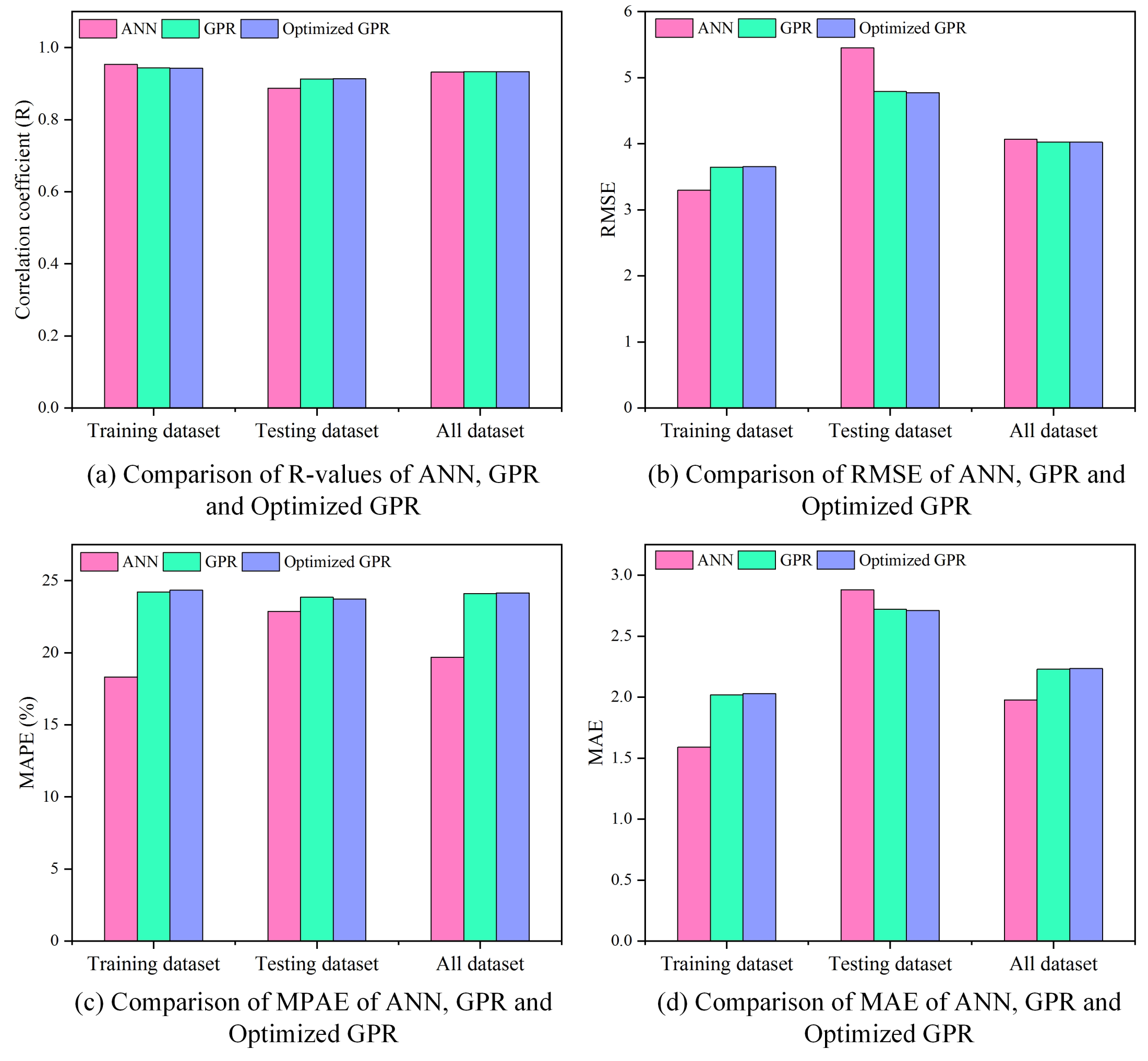
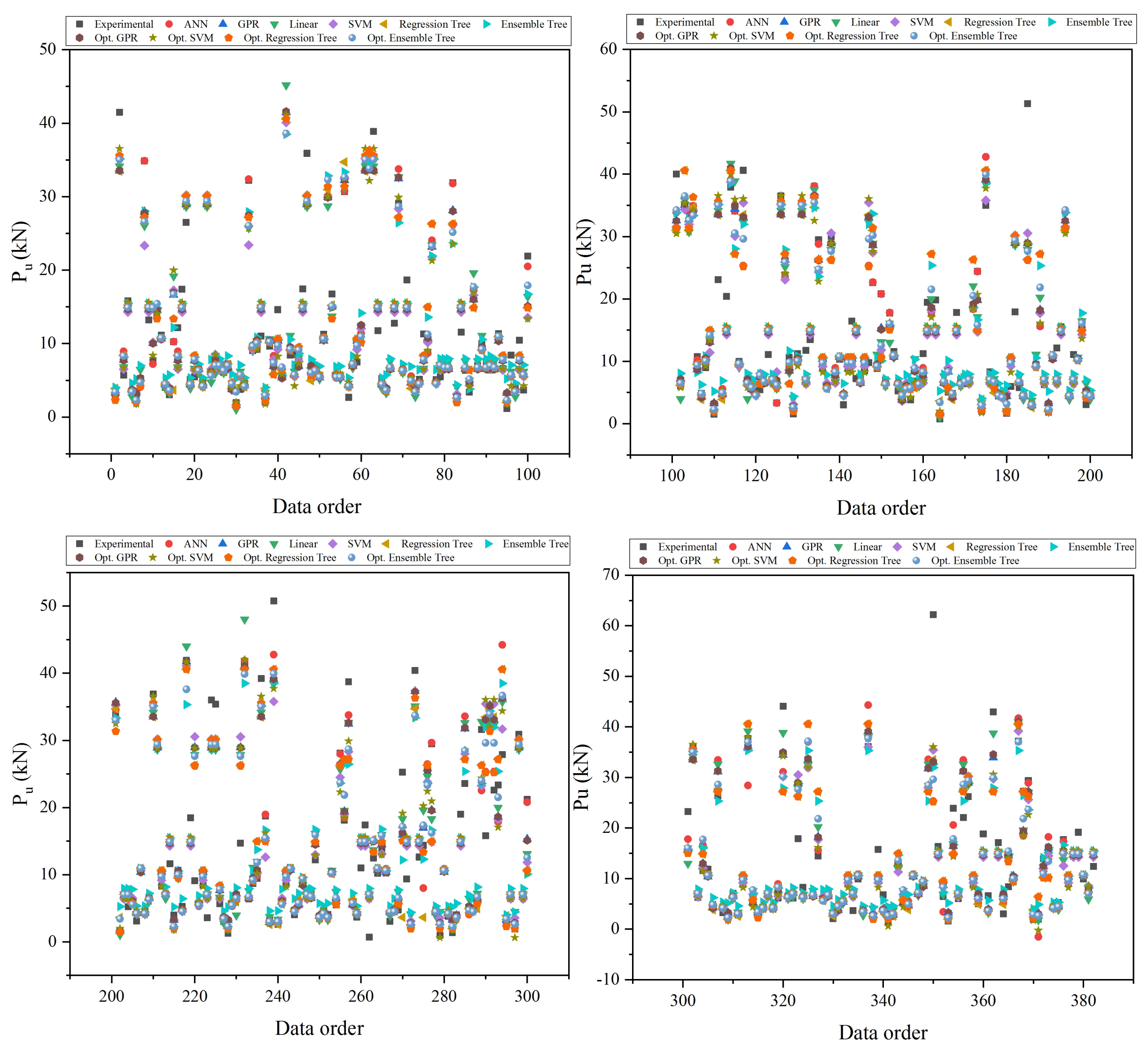
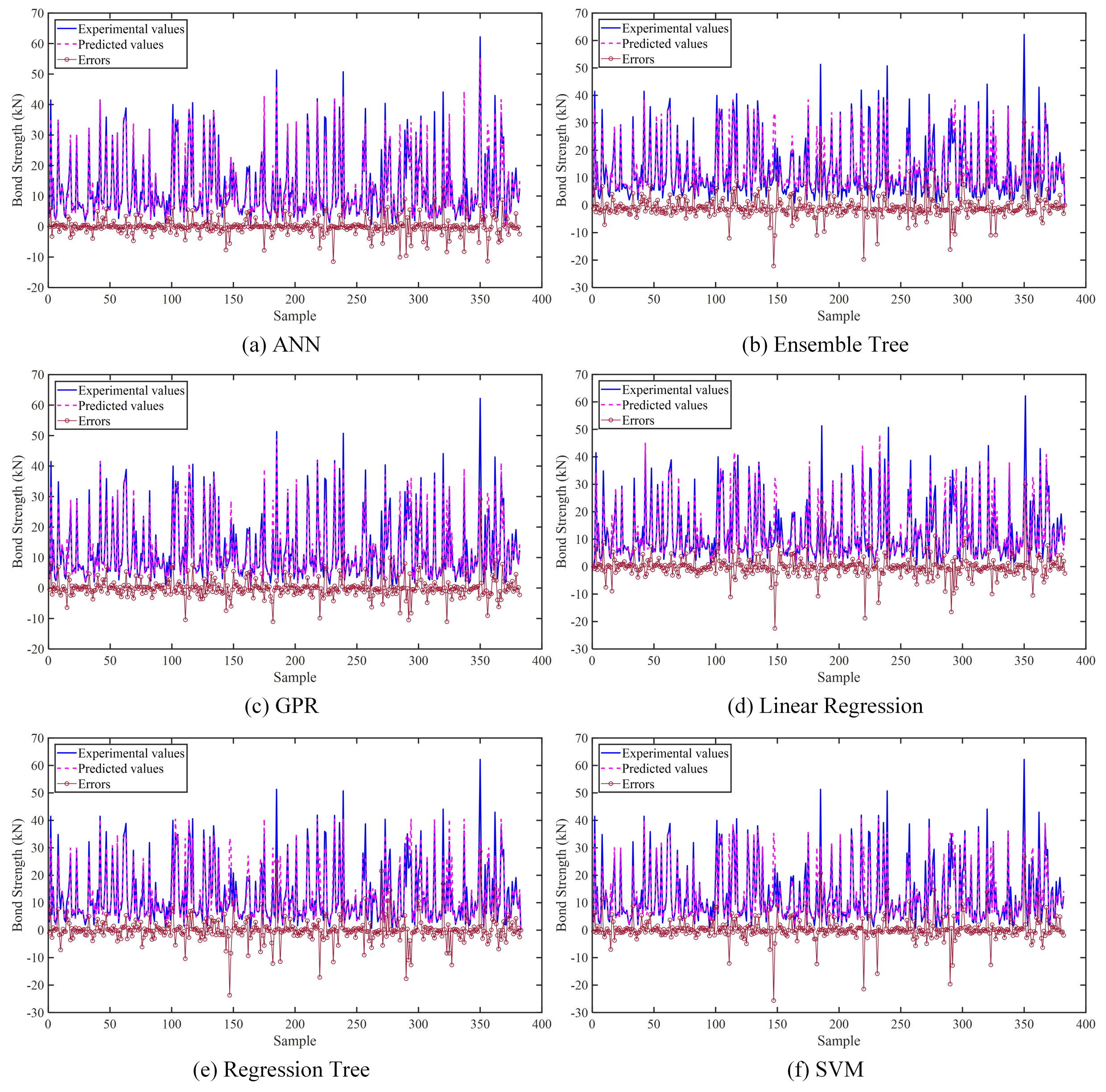
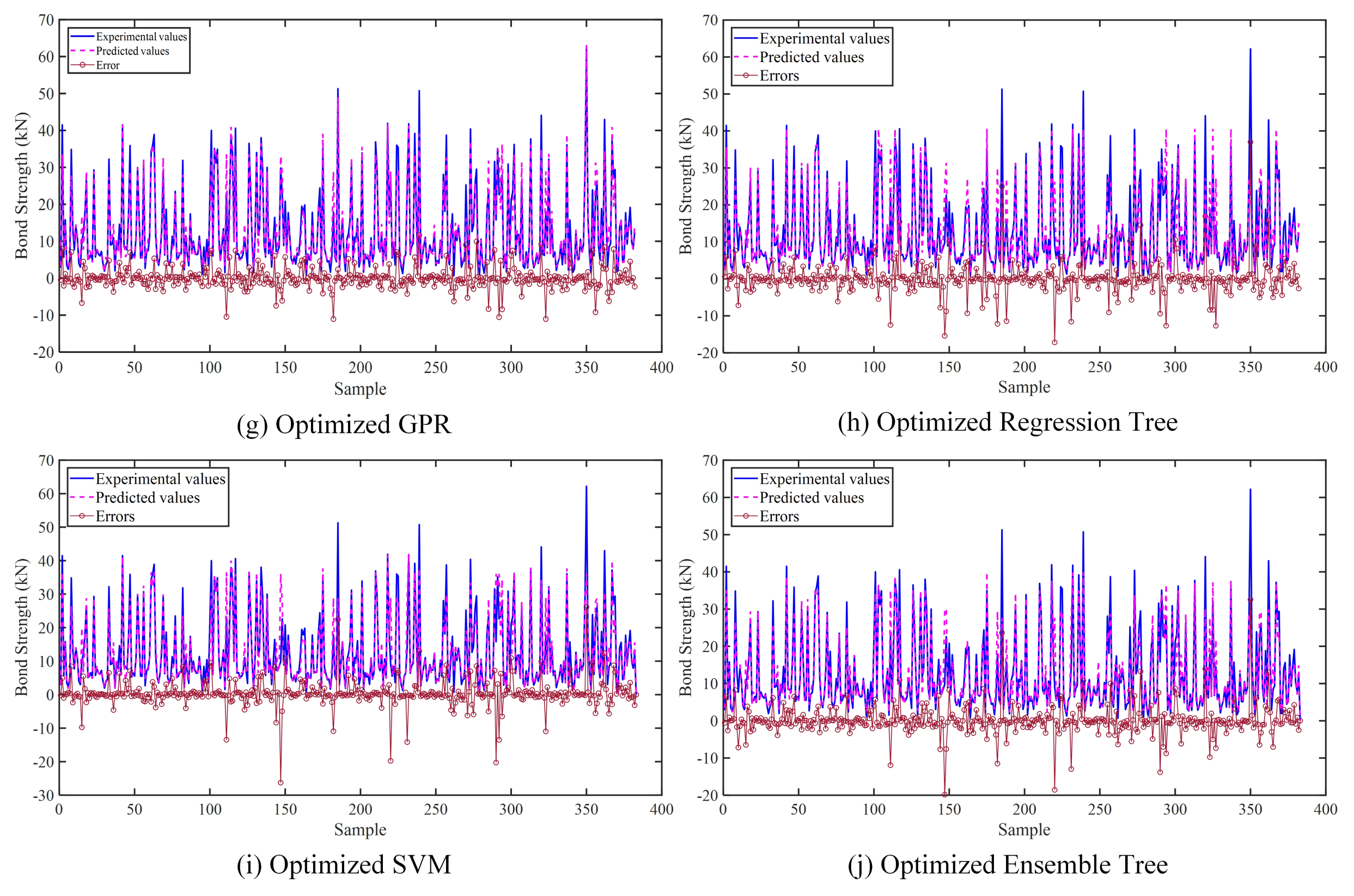
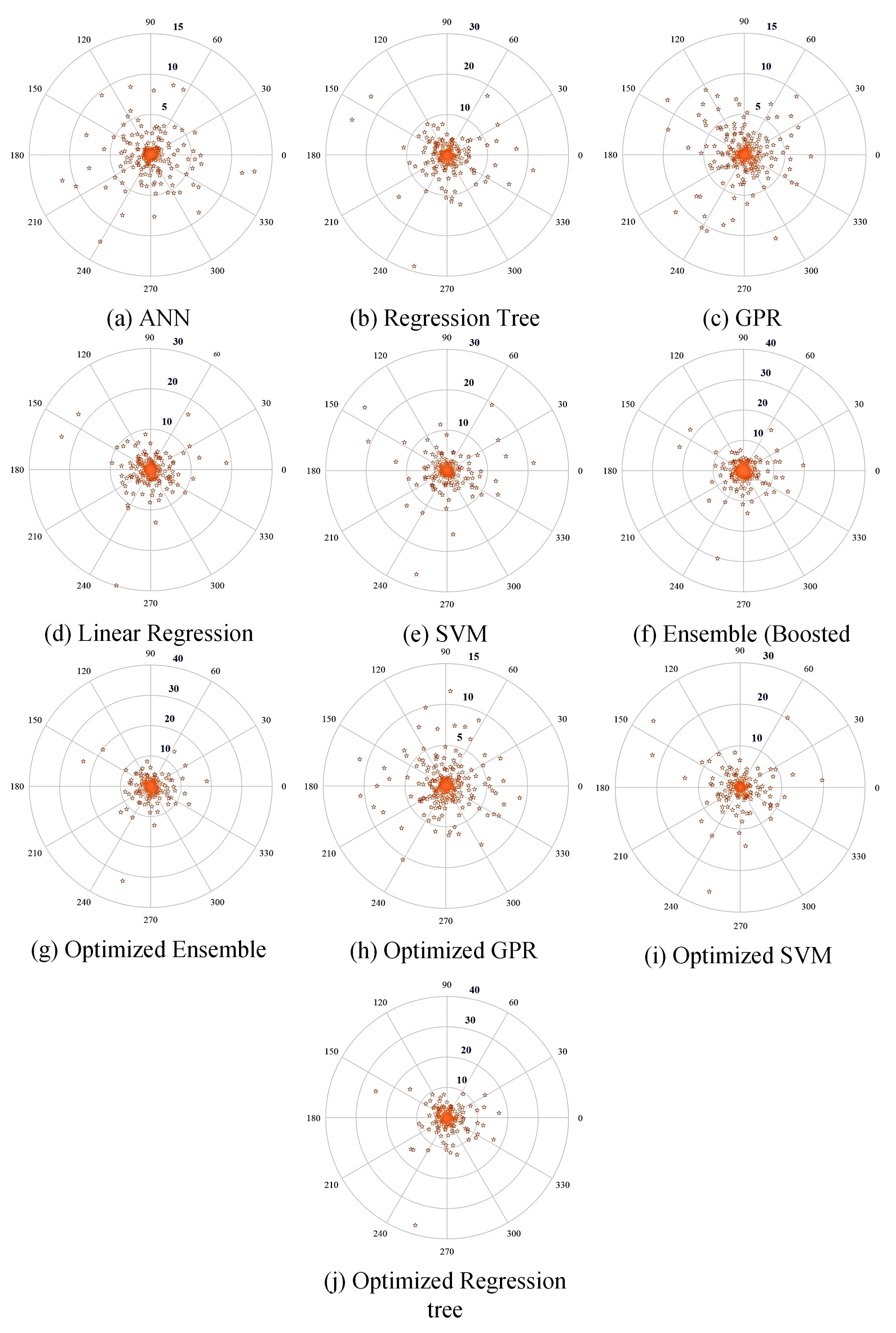
| Reference | n | b (mm) | f (MPa) | t (mm) | b (mm) | L (mm) | f (MPa) | E (GPa) | P (KN) |
|---|---|---|---|---|---|---|---|---|---|
| [75] | 1 | 100 | 30 | 10 | 100 | 50–250 | 5213–5391 | 271–273 | 5.19–15.64 |
| [76] | 1 | 150 | 55 | 5–10 | 75–150 | 75–150 | 3800 | 230 | 8.34–44.1 |
| [77] | 1–4 | 100 | 14.7–32.8 | 6 | 80 | 50–450 | 3800 | 225 | 7.7–50.75 |
| [72] | 3–4 | 100 | 29.7–33.7 | 6 | 80 | 200 | 1518 | 166.8 | 9.1–62.2 |
| [68] | 1 | 150 | 16.8 | 8 | 50 | 100–400 | 1470 | 73.5 | 4.76–7.9 |
| [69] | 1 | 120 | 20.6 | 10 | 90 | 50–260 | 1089 | 56 | 1.984–5.746 |
| [70] | 1 | 125 | 33.5 | 10 | 34–100 | 100–450 | 3014 | 206 | 3–21.21 |
| [78] | 1–2 | 100 | 30 | 10–13 | 100 | 75–200 | 767–1235 | 80–270 | 3.34–29.5 |
| [79] | 1 | 100 | 40–59.3 | 6–8 | 60–100 | 100–330 | 4660–4700 | 231–240 | 0.78–3.97 |
| [80] | 1 | 100 | 39–41 | 12 | 100 | 250–400 | 5800 | 278 | 8.98–11.86 |
| [81] | 1–2 | 125 | 42.5 | 4–8 | 34–60 | 100–330 | 5800 | 270 | 0.97–8.29 |
| [82] | 1 | 150 | 50 | 10 | 50 | 150 | 4400 | 260 | 7.24–20.39 |
| [83] | 1 | 125 | 26.9–33.5 | 10 | 60–80 | 330–450 | 3014 | 206 | 0.7–10.01 |
| Parameter | Symbol Used | Unit | Type | Mean | Min. | Max. | Std. |
|---|---|---|---|---|---|---|---|
| FRCM | n | - | Input | 1.5105 | 1 | 4 | 0.8925 |
| t | mm | Input | 8.7094 | 4 | 13 | 2.2028 | |
| b | mm | Input | 72.6649 | 34 | 150 | 24.0303 | |
| L | mm | Input | 232.8665 | 50 | 450 | 109.7950 | |
| f | MPa | Input | 3584.03 | 767 | 5800 | 1574.20 | |
| E | GPa | Input | 213.4932 | 56 | 278 | 62.0064 | |
| Concrete | b | mm | Input | 120.4581 | 100 | 150 | 17.6764 |
| f | MPa | Input | 35.9937 | 14.7000 | 59.30 | 9.8866 | |
| P | - | kN | Output | 12.7473 | 0.7000 | 62.2000 | 11.2335 |
| Model | Data Type | R | RMSE | MAPE (%) | MAE |
|---|---|---|---|---|---|
| ANN | Training | 0.9538 | 3.2952 | 18.3171 | 1.5887 |
| Testing | 0.8871 | 5.4525 | 22.8626 | 2.8800 | |
| Overall | 0.9321 | 4.0238 | 24.1089 | 2.2290 | |
| GPR | Training | 0.9435 | 3.6442 | 24.2188 | 2.0179 |
| Testing | 0.9130 | 4.7903 | 23.8539 | 2.7193 | |
| Overall | 0.9336 | 4.0238 | 24.1089 | 2.2291 | |
| SVM | Training | 0.9329 | 3.9657 | 24.4248 | 2.1105 |
| Testing | 0.9051 | 5.0348 | 24.8017 | 2.7395 | |
| Overall | 0.9239 | 4.3155 | 24.5383 | 2.2998 | |
| Linear | Training | 0.9360 | 3.8623 | 25.7076 | 2.2904 |
| Testing | 0.9127 | 4.8056 | 28.4808 | 2.8437 | |
| Overall | 0.9284 | 4.1688 | 26.5425 | 2.4570 | |
| Regression Tree | Training | 0.9287 | 4.0705 | 26.2388 | 2.3611 |
| Testing | 0.8729 | 5.7828 | 26.0152 | 3.2303 | |
| Overall | 0.9102 | 4.6527 | 26.1715 | 2.6228 | |
| Ensemble | Training | 0.9301 | 4.1701 | 41.1632 | 2.7784 |
| Testing | 0.8929 | 5.3720 | 40.2515 | 3.2918 | |
| Overall | 0.9176 | 4.5654 | 40.8887 | 2.9330 | |
| Optimized GPR | Training | 0.9432 | 3.6526 | 24.3401 | 2.0286 |
| Testing | 0.9137 | 4.7731 | 23.7343 | 2.7112 | |
| Overall | 0.9336 | 4.0229 | 24.1577 | 2.2341 | |
| Optimized SVM | Training | 0.9353 | 3.8944 | 19.9381 | 1.9364 |
| Testing | 0.9113 | 4.8730 | 20.7624 | 2.6893 | |
| Overall | 0.9275 | 4.2130 | 20.1863 | 2.1631 | |
| Optimized Ensemble | Training | 0.9404 | 3.7475 | 24.4664 | 2.1357 |
| Testing | 0.9042 | 5.0443 | 22.7060 | 2.7824 | |
| Overall | 0.9286 | 4.1804 | 23.9364 | 2.3303 | |
| Optimized Regression Tree | Training | 0.9329 | 3.9524 | 22.6536 | .2475 |
| Testing | 0.8822 | 5.5507 | 22.5035 | 2.9251 | |
| Overall | 0.9163 | 4.4944 | 22.7346 | 2.4553 |
Publisher’s Note: MDPI stays neutral with regard to jurisdictional claims in published maps and institutional affiliations. |
© 2022 by the authors. Licensee MDPI, Basel, Switzerland. This article is an open access article distributed under the terms and conditions of the Creative Commons Attribution (CC BY) license (https://creativecommons.org/licenses/by/4.0/).
Share and Cite
Kumar, A.; Arora, H.C.; Kumar, K.; Mohammed, M.A.; Majumdar, A.; Khamaksorn, A.; Thinnukool, O. Prediction of FRCM–Concrete Bond Strength with Machine Learning Approach. Sustainability 2022, 14, 845. https://doi.org/10.3390/su14020845
Kumar A, Arora HC, Kumar K, Mohammed MA, Majumdar A, Khamaksorn A, Thinnukool O. Prediction of FRCM–Concrete Bond Strength with Machine Learning Approach. Sustainability. 2022; 14(2):845. https://doi.org/10.3390/su14020845
Chicago/Turabian StyleKumar, Aman, Harish Chandra Arora, Krishna Kumar, Mazin Abed Mohammed, Arnab Majumdar, Achara Khamaksorn, and Orawit Thinnukool. 2022. "Prediction of FRCM–Concrete Bond Strength with Machine Learning Approach" Sustainability 14, no. 2: 845. https://doi.org/10.3390/su14020845
APA StyleKumar, A., Arora, H. C., Kumar, K., Mohammed, M. A., Majumdar, A., Khamaksorn, A., & Thinnukool, O. (2022). Prediction of FRCM–Concrete Bond Strength with Machine Learning Approach. Sustainability, 14(2), 845. https://doi.org/10.3390/su14020845









